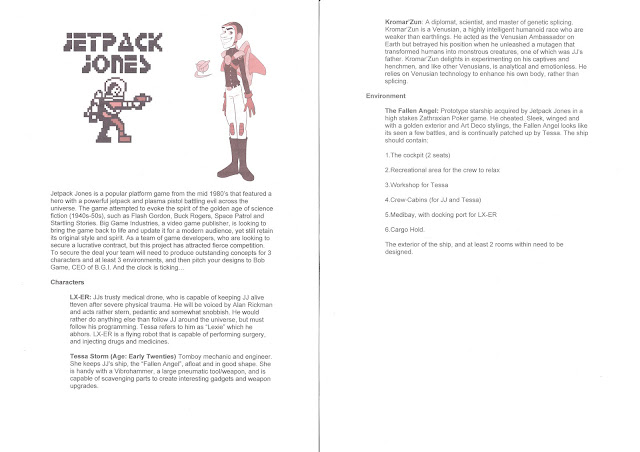CG Artist Toolkit- Character Design: 'Jetpack Jones'
Our last 'Character Design' workshop for this year had us putting our skills to practice, as 3 teams were formed from the entirety of group A.
Group 1 had Ciaran, Michael, Jen, Sam and myself.
We were told quickly that each group had been provided with a brief for some conceptual ideas to visualize the re-booted 'Jetpack Jones', a 1980's game that captured the 'golden age of science fiction- 1940's to the 1950's'. In this context however they'd also like to appeal to more modern day audiences.
Our immediate plan was to consider the overarching style of the designs, so that ideally each one would coincide with this universe.
Who was the show intended for, and what style were we aiming for?
At one point I'd suggested the 'Arcade' 1980's like style of the original game, in which details appear pixelated, and shape oriented.
However, we all swayed more for the 1940's-1950's style and theme... looking at 'Art Deco' and minimal design as a means of capturing what that era had considered 'the future' of space travel etc.
Characters
Ciaran and myself started sketching the third character: Kromar'Zun, and bouncing ideas back and forth about the 'weak' but quite 'analytical' and 'emotionless' villain.
As a humanoid race he would in some way resemble a man, but being weak, would be quite twig-like, bony and tall-ish, to emphasis height to width.
The technology he relies on was tricky to consider, because it would have to- in some way- strengthen him up without weighing him down completely.
The goggles/mask help obscure his obvious facial expressions, making him seem a less trusting character to the audience .
Upon reflection I think we should have considered the more 'diplomatic' background in more depth, as at this point there's no visual evidence of this.
Also perhaps more research and consideration for 'Venus' and the conditions of the planet.
Luckily Ciaran had suggested a volcanic Laboratory, but apart from that there wasn't much more consideration of life in that terrain.
Additionally this activity showed just how quickly one had to respond to new demands, and work efficiently as a team. It was nerve racking but fun trying to bounce ideas off visually, and having everyone make useful suggestions for one another's work.
The only problem was that it was often tricky for all of us to be kept in the loop of what's the latest demands. Incidentally we'd missed the 'message' of a later 'Romantic Interest' being the villains daughter- and thus should show resemblance of such.
We had, however, planned it at each step at a time, in how long everyone would be working on what, who should consult who (there were times when someone had to take a different job, that had links to another someone else had done. In which case that original design should be shown to the other designer to work with), and when we should get back to one another to reflect on designs, and decide what we should do next.
Also there's a lot of trying to work efficiently and calmly, in response to each demand.
On-Ship.
The Fallen Angel
Being slim and sleek, the ship had to appear quite fast travelling in it's design. The wings I had running horizontal to the main body to allow a more steam-line design.
The repetitive and intricate look to 'Art Deco' I'd used in the making of the windows (in the cockpit, as seen below), and in mirroring the entirety of the ship.
When Michael, Ciaran and myself got back to one another with each of our designs, we merged the 3 together to create the following:
At one point I'd thought about the rooms falling into a patterned like order, much like the original reference image. However, this could've proven difficult to get around.
Medical Bay
Jen had designed the medical bay which would take these exterior elements, and show them within an interior context.The idea was to have the bay a relatively small space, which (due to it's unavailable re-design in it's later prototypes), used lifting panels- as part of the walls and floor itself, so that LX-ER can retrieve only what he needs (from the central panel and docking bay), retaining the necessary space needed for him to manoeuvre to the main bay.
Off-Ship.
Lab
Here are some quick sketches made when establishing what our design for the laboratory would be. The right drawing shows what we were thinking in terms of the test tubes.The left-hand drawing illustrates the floor panels that allow Kromar'Zun to reach different test tubes easily, in a 'alien-like' way.

We re-designed the floor plan to be circular, to again mess with that expectation we have of architecture in potential rooms.
In the middle (perhaps a hazard if not watched out for), is a inclining pit where genetic experiments are put and observed in their final stages, to see whether his alterations have worked quickly, and efficiently.
Krok's Weaponry
Krok was a challenge. How do you create a weaponry for a henchmen that lack the mental capacity, but was made by a genius in slice genetic engineering?
The weapons varied from raw materials, simple and the mere basics capable of being shoved together by Krok... to more organic-like weapons that would either resemble himself, or be part of his actual body.
Sam worked more into the character, (since these designs above were the quickest, and the youngest versions of the 'weapon' attached henchman), by merging one of his bigger weapons into the bottom half of his right arm.
Overall, the session had been a helpful glimpse at the sort of work that we'll be doing in actual practice. It's brought some room for improvement to light, and ideas about what kind of work we'll be involved in.














Comments
Post a Comment